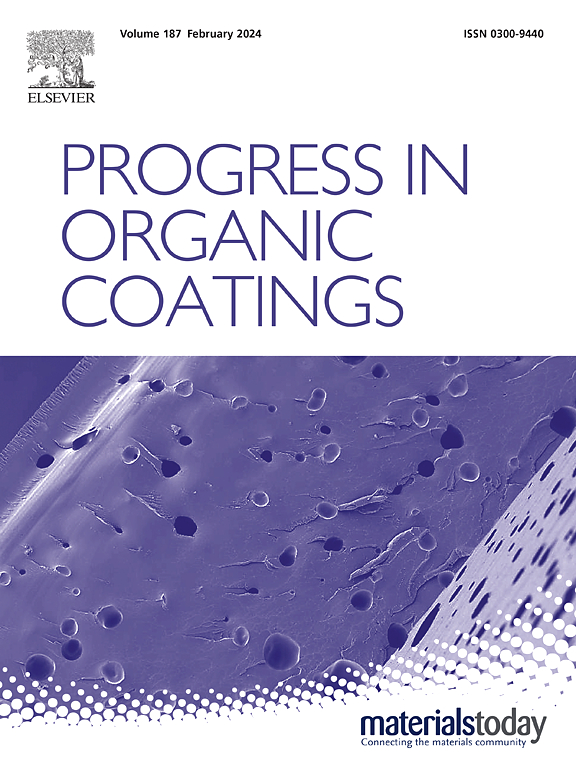Development of lychee-like core-shell chlorophyll/epoxy@SiO2 microspheres via Pickering emulsion polymerization for enhanced photostability
IF 6.5
2区 材料科学
Q1 CHEMISTRY, APPLIED
引用次数: 0
Abstract
Chlorophyll (Chl), a natural pigment with significant applications in functional coatings, food processing and biomedical fields, suffers from poor photostability under light and oxygen exposure, limiting its practical use. Herein, a novel chlorophyll/epoxy@SiO2 (Chl/EP@SiO2) microsphere with a lychee-like core-shell structure was synthesized via Pickering emulsion polymerization. The modification level and amount of SiO2 were systematically optimized, yielding microspheres with an average particle size of ∼15 μm and a shell thickness ranging from 0.9 to 1 μm. Two distinct preparation strategies were investigated: (i) incorporating Chl during emulsification step by premixing with bisphenol A diglycidyl ether (DGEBA) to produce ChlD/EP@SiO2 microspheres, and (ii) introducing Chl during curing phase by mixing with m-xylylenediamine (MXDA) to form ChlM/EP@SiO2 microspheres. ChlD/EP@SiO2 microspheres exhibited uniform particle size distribution, with Chl showing no interference with the diffusion of MXDA or the curing reaction. Conversely, the diffusion of Chl in the curing process disrupted the SiO2 adsorption equilibrium, leading to particle rearrangement, surface roughness, and non-uniform particle size distribution in ChlM/EP@SiO2. Reflectance spectra and colorimetric analysis during photostability tests demonstrated that ChlD/EP@SiO2 microspheres, used as fillers in polyurethane coatings, enhanced Chl photostability by 11-fold compared to unencapsulated Chl. Furthermore, encapsulating Chl within an epoxy core and SiO2 shell improved its dispersion in waterborne polyurethane coatings. This lychee-like core-shell composite microsphere provides a promising platform for stabilizing and dispersing organic pigments in coating applications.
叶绿素(Chl)是一种天然色素,在功能涂料、食品加工和生物医学领域有着重要的应用,但其在光和氧暴露下的光稳定性较差,限制了其实际应用。本文通过皮克林乳液聚合法合成了具有荔枝核壳结构的新型叶绿素/环氧@SiO2(Chl/EP@SiO2)微球。对改性水平和 SiO2 的用量进行了系统优化,得到的微球平均粒径为 15 μm,壳厚度为 0.9 至 1 μm。研究了两种不同的制备策略:(i) 通过与双酚 A 二缩水甘油醚(DGEBA)预混合,在乳化步骤中加入 Chl,制备 ChlD/EP@SiO2 微球;(ii) 通过与间羟基二胺(MXDA)混合,在固化阶段引入 Chl,形成 ChlM/EP@SiO2 微球。ChlD/EP@SiO2 微球的粒度分布均匀,Chl 对 MXDA 的扩散和固化反应没有干扰。相反,Chl 在固化过程中的扩散破坏了 SiO2 的吸附平衡,导致 ChlM/EP@SiO2 微粒重新排列、表面粗糙和粒度分布不均匀。光稳定性测试中的反射光谱和比色分析表明,ChlD/EP@SiO2 微球用作聚氨酯涂层的填料,与未封装的 Chl 相比,Chl 的光稳定性提高了 11 倍。此外,将 Chl 包裹在环氧树脂内核和 SiO2 外壳中还能改善其在水性聚氨酯涂料中的分散性。这种荔枝核-壳复合微球为涂料应用中有机颜料的稳定和分散提供了一个前景广阔的平台。
本文章由计算机程序翻译,如有差异,请以英文原文为准。
求助全文
约1分钟内获得全文
求助全文
来源期刊

Progress in Organic Coatings
工程技术-材料科学:膜
CiteScore
11.40
自引率
15.20%
发文量
577
审稿时长
48 days
期刊介绍:
The aim of this international journal is to analyse and publicise the progress and current state of knowledge in the field of organic coatings and related materials. The Editors and the Editorial Board members will solicit both review and research papers from academic and industrial scientists who are actively engaged in research and development or, in the case of review papers, have extensive experience in the subject to be reviewed. Unsolicited manuscripts will be accepted if they meet the journal''s requirements. The journal publishes papers dealing with such subjects as:
• Chemical, physical and technological properties of organic coatings and related materials
• Problems and methods of preparation, manufacture and application of these materials
• Performance, testing and analysis.
 求助内容:
求助内容: 应助结果提醒方式:
应助结果提醒方式:


